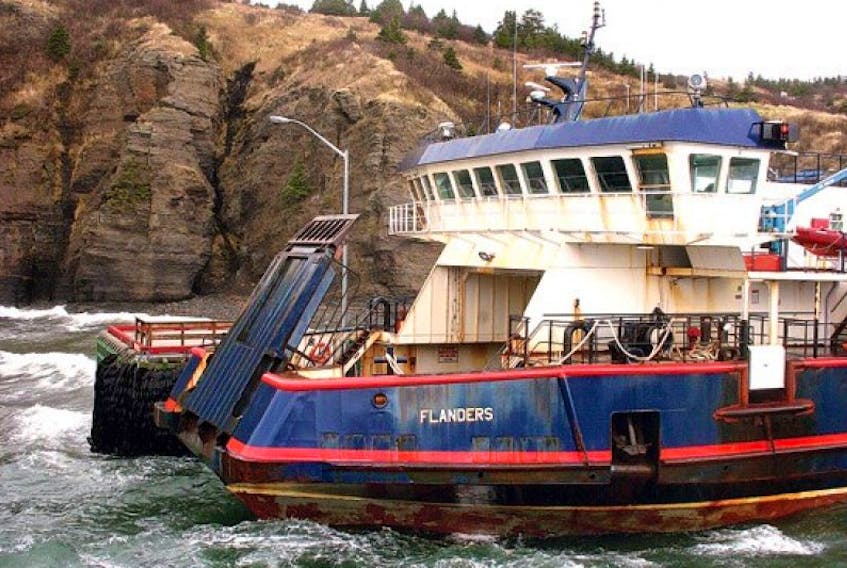There’s an old saying about the expenses involved in owning a ship — that a boat is a hole in the water into which you pour money.

Well, the government of this province owns boats, and pours plenty of money.
Every month, the provincial government publishes a document about the things it buys without going to tender — often, because a “pressing emergency” means there’s not time to get bids, and other times, because the equipment can only come from one supplier anyway.
The reports feature everything from medical equipment to textbooks, but almost every month, they include unexpected emergency repairs to the provincial ferry fleet.
For three months of this year, the government needed $18,244 in engine parts for the nearly new MV Veteran, along with $11,790 in emergency engine oil for the same vessel and a further $11,000 in main engine parts. The MV Flanders needed $150,000 in untendered corrosion protection. The MV Beaumont Hamel needed $22,000 to repair an engine manifold leak and $46,800 in bow thruster repairs. The MV Gallipoli needed $19,500 in pumps and piping, and the MV Sound of Islay needed $58,000 in gear box repairs. The MV Legionnaire needed $12,500 for particular engine oil and lubricants that could only be purchased from a single supplier.
And this year’s been quiet: there have been months where the government has reported six and even seven sets of emergency vessel repairs in a single 30-day period.
The reports feature everything from medical equipment to textbooks, but almost every month, they include unexpected emergency repairs to the provincial ferry fleet.
As well, those are only the untendered amounts; the MV Gallipoli is currently undergoing what was supposed to be a $1.6-million refit in Clarenville, a refit that the CBC reports has been extended until April — an extra four months — because of unexpected corrosion problems. The final price is now under negotiation.
The MV Sound of Islay, already almost 50 years old, just finished a $4.6-million refit to help it eke out another eight to 10 years on the water. (To give you an idea of just how old the Sound of Islay actually is, when the vessel was built in Scotland in 1968, Pierre Trudeau was just becoming Canada’s prime minister. The provincial licence plate slogan that year? “Newfoundland and Labrador — Canada’s Happy Province.”)
You can argue about who benefits the most, economically, from the provincial ferry fleet — whether it’s the isolated communities that depend on the vessels (and for whom as much as 95 per cent of the costs are carried by the provincial government), or the shipyards and suppliers in this province that benefit from landing all of the tendered and untendered work on the oft-troublesome fleet.
That’s because any ship repair facility can bid to repair or refit the ferry vessels — but they can only actually win the contract if they happen to have repair facilities already located on the island part of the province.
Tenders for major ferry repairs traditionally include two cunning little clauses: “Due to operational restrictions vessel is unable to travel outside of the territorial waters of the island portion of the province of Newfoundland and Labrador,” and “Due to provincial Occupational Health and Safety jurisdiction, vessel is unable to travel outside of the province of Newfoundland and Labrador.”
It makes the provincial ferry system an anchor client for the province’s shipyards; work tends to be done either at the Newdock facility in St. John’s, or at Burry’s Shipyard in Clarenville. (It’s an interesting and handy way to keep government spending inside the province, despite open government procurement agreements.)
The province’s ferry operations are currently a $91-million-a-year operation, including everything from ferry repair costs to terminals to crewing costs. About $7.7 million of that is recaptured in the fares charged for the service.
The rest is shared across all of the taxpayers in the province.
Boats break down and they corrode – it’s a fact of marine life. Older boats usually break down and corrode even more. Right now, though, the new $50-million MV Veteran is tied up in St. John’s, awaiting thruster repairs, where it’s been since late October.
The only thing we really know for certain? As long as the province is in the ferry business the way it is, throwing money into those holes in the water will be a $1.7-million-a-week expense.
Russell Wangersky’s column appears in 39 SaltWire newspapers and websites in Atlantic Canada. He can be reached at [email protected] — Twitter: @wangersky.








